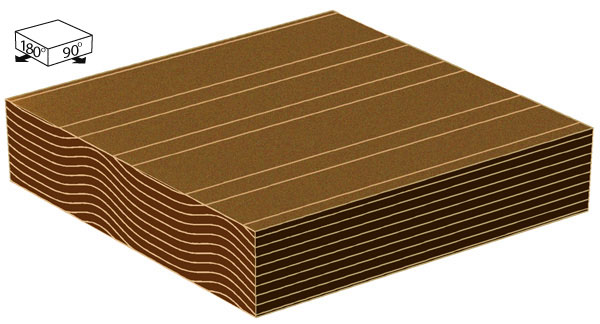Pacific Coastal and Marine Science Center
Bedform Sedimentology Site: “Bedforms and Cross-Bedding in Animation”


FIG. 3. Structure formed by two-dimensional bedforms climbing vertically. Other names for similar structures are: ripple- laminae in phase (McKee, 1939, 1965), sinusoidal lamination (Jopling and Walker, 1968), draped lamination (Gustavson and others, 1975; Ashley and others, 1982), and complete rippleform lamination (Hunter, 1977). Most of these earlier terms are less restrictive as they also apply to structures deposited by bedforms climbing at nonvertical stoss-depositional angles and to structures deposited by three-dimensional bedforms. Vertically climbing bedforms that are three-dimensional or variable (or both) are simulated in Figures 18, 19, 55, 56, 77, and 78. Real structures deposited by bedforms that at times climbed vertically are shown in Figures 7, 20, and 64.
RECOGNITION: This structure differs in origin from other invariable two-dimensional cross-bedded structures by having a higher (vertical) angle of climb. The vertical angle of climb is indicated by the vertical alignment of bedform crests and troughs. Interpretation of bedform morphology is trivial, because the bedforms climb at such a high angle that depositional surfaces are completely preserved. The origin of the structure can also be recognized from the plots of cross-bed and bounding- surface dips. Stoss-depositional climb is indicated by an absence of bounding surfaces, and a symmetrical bedform shape is suggested by symmetrical dip patterns relative to the center of the plot. The plot that is shown includes the dips of cross-beds in vertical profiles at many locations on the bedform surface. If a separate plot were shown for each vertical profile, dips of all beds in each profile would plot as a single point, because the dip azimuth and inclination in each profile are constant with depth.
ORIGIN: This structure is relatively rare because vertical climb of bedforms requires unusual circumstances: a flow that maintains bedforms and transports sediment to the depositional site but does not cause the bedforms to migrate. These conditions are met or approximated: (1) in flows over nonmigrating transverse bedforms such as some antidunes; (2) in steady flows over perfectly aligned longitudinal bedforms; (3) in directionally varying flows where bedforms trend exactly parallel to the resultant sediment transport direction (that is, the bedforms are perfectly longitudinal), and where short-term fluctuations in the transport direction move so little sediment that the bedforms do not migrate laterally or change shape with the individual fluctuations; unsteady flows that can produce longitudinal bedforms are those in which the transport direction varies by an angle of between 90 and 180 and in which transport from the two directions is equal FIG. B-1; Rubin and Hunter, 1987); (4) in unsteady flows where bedforms cease to be active, and vertical fallout drapes the bedforms with layers of sediment; this is probably one of the more common processes for creating thin deposits of vertically climbing bedforms, but, if the flow does not actively maintain the bedforms, vertical fallout will reduce the bedform height and eventually will destroy or bury the bedforms; (5) in flows where slow-velocity sediment-laden flows rain sediment down preferentially on the upcurrent-facing slopes of bedforms, thus balancing the volume of sediment trapped on lee slopes. Under some flow conditions, the rate of deposition on upcurrent-facing slopes can exceed that on lee slopes, and bedforms migrate upcurrent. This process may explain the commonly observed upslope migration of deep-sea mud waves, and this process seems to be the best explanation for the slight upcurrent migration exhibited by some ripples climbing at nearly vertical angles, such as those illustrated by Jopling and Walker (1968, center of FIG. 7). Sediment cohesion may limit stoss-side erosion, thereby enabling higher angles of climb or upcurrent migration (Jopling and Walker, 1968). Because this structure can be produced by transverse and longitudinal bedforms, and probably also by oblique bedforms, it is not a useful indicator of transport directions.